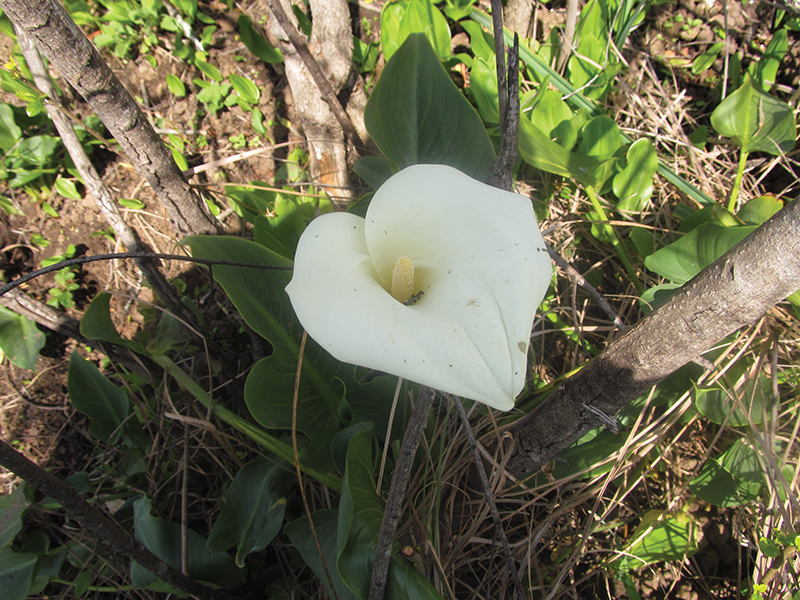
Name: Zantedeschia aethiopica (L.) Spreng.
Family: Araceae (Arum family)
Common names:
English: Arum lily, Calla Lily, Egyptian Lily, Florist’s Calla, Garden Calla,
Afrikaans: Aronskelk, Hottentotsblare, Hottentotsbrood, Varkblaar, Varkblom, Varklelie, Varkoor
Xhosa: Inyibaba
Popular garden plant and cut-flower that tolerates snow.
Description
Evergreen or deciduous perennial, 60-100cm, often massed with plain green, arrow-shaped leaves, and a large, pure white floral spathe; the fruiting stems remaining erect. Flowers spathe, funnel-shaped, white, upper part withers, lower part turns green through the year, faintly scented. Root stock is a stout and fleshy rhizome. Leaves (about five) clasp at the base. Fruits are numerous on the spadix, and are surrounded by the persistent spathe.
Conservation status
According to the SANBI (South African National Biodiversity Institute) Red list of South African Plants, Zantedeschia aethiopica was not selected in any one of four screening processes for highlighting potential taxa of conservation concern for detailed assessment and was hence given an automated status of Least Concern (LC). http://redlist.sanbi.org
Distribution and habitat
Aethiopica is exceptionally common and occurs over large part of South Africa, where it grows only in wet or seasonally wet places. Provincial distribution: Eastern Cape, Free State, Gauteng, KwaZulu-Natal, Limpopo, Mpumalanga, Northern Cape, North West and Western Cape.
Derivation of name and historical aspects
The use of the term Arum results from superficial resemblance of the South Africa plants to members of the genus Arum occurring in Europe and western Asia. Zantedeschia genus was named by Sprengel in 1826 in honour of a professor Zantedeschia. There is uncertainty, however over whether Giovanni or Francesco Zantedeschia was intended.
Ecology
The flowers are faintly scented which attracts various crawling insects and bees which are responsible for pollinating the flowers. Cross pollination occurs as the anthers of each flower ripen before the ovaries. A white crab spider of the family Thomisidae visits the flower to eat the insects. This spider does not spin a web; instead using its whiteness as camouflage against the spathe. In the Western Cape, a tiny frog Hyperolius hopstocki is also attracted to the arum lily flowers. The spathe turns green after flowering and covers the ripening berries. It rots away when these ripen, and the succulent yellow berries attract berries birds, which are responsible for seed dispersal. The leaves of the arum are quite interesting in that they contain water stomata which can discharge excess water, by a process known as “guttation”. This prevents water-logging and enables arum lilies to grow in wet conditions.
Uses and cultural aspects
Lily Leaves have been widely used in South Africa to treat wounds, sores and boils. It was also applied to parts affected by rheumatism and gout. Boiled rhizomes were sometimes mixed with honey or syrup and drunk for bronchitis, asthma, heartburn and rheumatism; or gargled for a sore throat. Pounded rhizome, used as a poultice, is an old Cape treatment for inflamed wounds.
The fresh leaf is warmed before application to the affected area. Plant parts of the Araceae family should not be eaten fresh as it results in swelling of the tongue and throat, due to needle-shaped calcium oxalate crystals, causing mechanical irritation
Growing Zantedeschia aethiopica
Hardy forms
The handy forms of Zantedeschia are Zantedeschia aethiopica and Z. pentlandii and their cultivars, also called arum lilies.
Arum lilies thrive in moist soil in full to partial shade. Choose a sheltered position and add some well-rotted organic matter before planting. Water freely throughout the summer, and feed fortnightly with a balanced liquid fertiliser. Mulch annually in autumn with well-rotted garden compost or manure. Z. aethiopica can also be grown as a marginal plant in water up to 30cm deep. Use aquatic compost and a 30cm deep planting basket.
Container cultivation
When planting use a loam-based compost such as John Innes No. 2 and plant the rhizomes just showing at the surface of a container with eyes of the rhizome uppermost. Water freely through the summer and feed with a balanced liquid fertitiser very two weeks until the flowers have faded.
Propagation
Propagate can be by division, in spring. Small rhizomes that been overwintered in pots under cover can literally be cut up into sections, each with a visible bud. Large overwintered clumps in the garden can be divide in the same way as other perennials, by lifting the plant before there is much top growth, and chopping through the roots with spade and dividing into smaller sections.
Plants can also be grown from seed in spring, sowing, one seed per 8cm pot and maintaining a temperature of 20°C. Germination should take place after a few weeks, but will not flower for two or three years.
References and further reading
Batten, A. & Bokelmann. H. 2011. Wild Flowers of the Eastern Cape Province. 1966. Books of Africa, 1005 Cape of Goodhope Savings Bank Building, St. George’s Street, Cape Town.
Letty, C. The Genus Zantedeschia – Bothalia. 1973. https://abcjournal.org/index.php/ABC/article/viewFile/1963/1895
Pooley, E. 2005. A Field Guide to Wild Flowers, KwaZulu-Natal and the Eastern Region. The Flora Publications Trust, c/o Natal Herbarium, Botanical Gardens Road, Durban 4001.
Van Wyk, B.E., van Oudtshoorn, B., Gericke, N. Medicinal Plants of South Africa. Briza Publications, Pretoria.
http://pza.sanbi.org/zantedeschia-aethiopica; https://www.rhs.org.uk/advice/profile?PID=177


